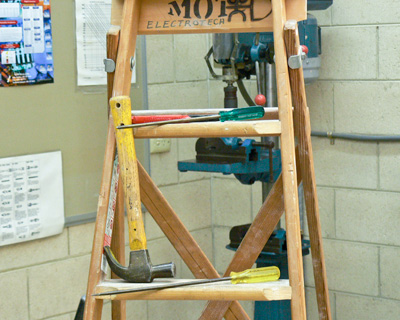OHS practices - Situations
Height
Not all electrical installation work can be done on the ground floor or at floor level. To perform installation work above floor level, a ladder or scaffolding is required. Scaffolding over two metres in height requires a permit and must comply with state or territory legislation.

Unsafe positioning of tools on ladder
Ladder types
Portable ladders made of wood, aluminium or fibreglass are the most common available. The most frequently used ladders are step ladders, single ladders and extension ladders.
Portable ladders are designed for one-man operation and are constructed under two general classes:
- Type I Industrial - heavy duty with a minimum load ration of 120kg
- Type II Domestic - light duty with a maximum load rating of 100kg.
Only industrial wooden or fibreglass ladders stamped with the AS/NZS mark must be used by electricians when carrying out their activities.
All ladders should be inspected on delivery, after suspected damage, and once every six months.
Using ladders
When using a ladder the following rules should be adhered to.
- Always face the ladder when ascending or descending.
- Ascend or descend one rung at a time.
- Always have three limbs ( two arms and one leg, or one arm and two legs) on the ladder rungs at one time.
- Never hand-carry equipment or tools on a ladder - use tool belts.
- Never over-reach in order to carry out a task; move the ladder.
- Always place the ladder on firm or level ground.
- Ensure that the support for the top of the ladder is secure.
- To prevent a ladder from slipping use non-skid feet, spurs, tie off top and bottom, or have another person place their foot against the base.
- Do not stand on the ladders' top two rungs.
- Check the ladder for a damaged side rail which may cause one side of a ladder to give way.
- Don't leave tools on ladders.
- The base of a single or extension ladder should be at a slope of 4:1 ( 1 metre high 250mm out ) away from the structure it leans against.
- Ladders used to reach a walking surface or roof must extend at least one metre beyond.
- Extension ladders need both locks holding to precent overloading a rail.
- Do not use wet wooden or fibreglass ladders as electric shock can occur. Not only is the shock itself hazardous, but its effect can also cause a fall resulting in injury.
- Never leave ladders unattended.
- Only one person may be on a ladder at any one time.
- Never walk a ladder to an adjacent location by standing on the ladder and lifting a stile.



